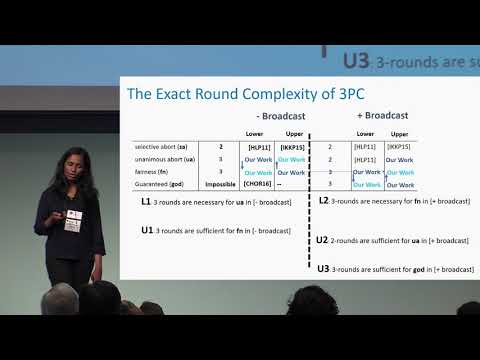Welcome to the resource topic for 2018/481
Title:
On the Exact Round Complexity of Secure Three-Party Computation
Authors: Arpita Patra, Divya Ravi
Abstract:We settle the exact round complexity of three-party computation (3PC) in honest-majority setting, for a range of security notions such as selective abort, unanimous abort, fairness and guaranteed output delivery. Selective abort security, the weakest in the lot, allows the corrupt parties to selectively deprive some of the honest parties of the output. In the mildly stronger version of unanimous abort, either all or none of the honest parties receive the output. Fairness implies that the corrupted parties receive their output only if all honest parties receive output and lastly, the strongest notion of guaranteed output delivery implies that the corrupted parties cannot prevent honest parties from receiving their output. It is a folklore that the implication holds from the guaranteed output delivery to fairness to unanimous abort to selective abort. We focus on two network settings-- pairwise-private channels without and with a broadcast channel. In the minimal setting of pairwise-private channels, 3PC with selective abort is known to be feasible in just two rounds, while guaranteed output delivery is infeasible to achieve irrespective of the number of rounds. Settling the quest for exact round complexity of 3PC in this setting, we show that three rounds are necessary and sufficient for unanimous abort and fairness. Extending our study to the setting with an additional broadcast channel, we show that while unanimous abort is achievable in just two rounds, three rounds are necessary and sufficient for fairness and guaranteed output delivery. Our lower bound results extend for any number of parties in honest majority setting and imply tightness of several known constructions. The fundamental concept of garbled circuits underlies all our upper bounds. Concretely, our constructions involve transmitting and evaluating only constant number of garbled circuits. Assumption-wise, our constructions rely on injective (one-to-one) one-way functions.
ePrint: https://eprint.iacr.org/2018/481
Talk: https://www.youtube.com/watch?v=KsibRm2Zq7E
Slides: https://crypto.iacr.org/2018/slides/28820.pdf
See all topics related to this paper.
Feel free to post resources that are related to this paper below.
Example resources include: implementations, explanation materials, talks, slides, links to previous discussions on other websites.
For more information, see the rules for Resource Topics .
